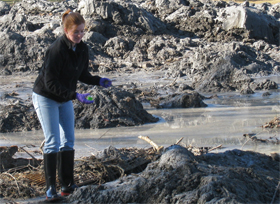
“The take-away lesson is we need to change how and where we look for coal ash contaminants,” says Avner Vengosh, professor of geochemistry and water quality at Duke’s Nicholas School of the Environment. “Risks to water quality and aquatic life don’t end with surface water contamination, but much of our current monitoring does.”
The study, published online this week in the peer-reviewed journal Environmental Science and Technology, documents contaminant levels in aquatic ecosystems over an 18-month period following a massive coal sludge spill in 2008 at a Tennessee Valley Authority power plant in Kingston, Tenn.
The potential impacts of pore water contamination extend far beyond the river bottom, he explains, because “this is where the biological food chain begins, so any bioaccumulation of toxins will start here.”
The research team, which included two graduate students from Duke’s Nicholas School of the Environment and Pratt School of Engineering, also found that acidity and the loss or gain of oxygen in water play key roles in controlling how arsenic, selenium and other coal ash contaminants leach into the environment. Knowing this will help scientists better predict the fate and migration of contaminants derived from coal ash residues, particularly those stored in holding ponds and landfills, as well as any potential leakage into lakes, rivers and other aquatic systems.
The study comes as the EPA is considering whether to define ash from coal-burning power plants as hazardous waste. The deadline for public comment to the EPA was Nov. 19; a final ruling — what Vengosh calls “a defining moment” — is expected in coming months.
“At more than 3.7 million cubic meters, the scope of the TVA spill is unprecedented, but similar processes are taking place in holding ponds, landfills and other coal ash storage facilities across the nation,” he says. “As long as coal ash isn’t regulated as hazardous waste, there is no way to prevent discharges of contaminants from these facilities and protect the environment.”










